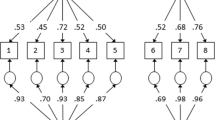Abstract
The tendency to engage in depressive rumination is typically measured with the Ruminative Response Styles (RRS) scale. Treynor et al. (2003) reported that this scale is composed of two 5-item factors, reflection and brooding, and that the brooding but not the reflection factor is associated with more severe depression over time. These two factors were derived using data from a randomly selected community sample, and it is not clear if these factors would be obtained in samples of currently depressed, formerly depressed, and never depressed individuals. We conducted factor analyses on scores on the RRS scale from three such samples. We found support for the distinction between reflection and brooding in never depressed and formerly depressed individuals; we did not obtain this distinct factor structure in the currently depressed sample. We did, however, find evidence of a second factor in the depressed sample that we labeled ‘intentional rumination.’ The results of this study also suggested that an item from the reflection factor should be replaced with another item from the RRS scale. These findings indicate that the distinction between brooding and reflection is blurred in currently depressed individuals.
Similar content being viewed by others
References
Bagby, R. M., Rector, N. A., Bacchiochi, J. R., & McBride, C. (2004). The stability of the response styles questionnaire rumination scale in a sample of patients with major depression. Cognitive Therapy and Research, 28, 527–538.
Beck, A. T., Steer, R. A., & Brown, G. K. (1996). Manual for the Beck Depression Inventory - II. San Antonio, TX: Psychological Corporation.
Conway, M., Csank, P. A. R., Holm, S. L., & Blake, C. K. (2000). On individual differences in rumination on sadness. Journal of Personality Assessment, 75, 404–425.
Costello, A. B., & Osborne, J. W. (2005). Best practices in exploratory factor analysis: four recommendations for getting the most from your analysis. Practical Assessment Research and Evaluation, 10(7), 1–9.
Fabrigar, L. R., Wegener, D. T., MacCallum, R. C., & Strahan, E. J. (1999). Evaluating the use of exploratory factor analysis in psychological research. Psychological Methods, 4(3), 272–299.
Ferguson, E., & Cox, T. (1993). Exploratory factor analysis: A user’s guide. International Journal of Selection and Assessment, 1, 84–94.
First, M. B., Spitzer, R. L., Gibbon, M., & Williams, J. B. W. (1995). The Structured Clinical Interview for DSM-IIIR Personality Disorders (SCID-II). Part I: Description. Journal of Personality Disorders, 9, 83–91.
Gotlib, I. H., Krasnoperova, E., Neubauer, D. L., & Joormann, J. (2004). Attentional biases for negative interpersonal stimuli in clinical depression. Journal of Abnormal Psychology, 113, 127–135.
Hair, J. F., Anderson, R. E., Tatham, R. L., & Black, W. C. (1998). Multivariate data analysis (5th ed.). Englewood Cliffs, NJ: Prentice Hall.
Horn, J. L. (1965). A rationale and test for the number of factors in factor analysis. Psychometrika, 30, 179–185.
Johnson, S. L., McKenzie, G., & McMurrich, S. (2008). Ruminative responses to negative and positive affect among students diagnosed with bipolar disorder and major depressive disorder. Cognitive Therapy and Research, 32, 702–713.
Jones, N. P., Siegle, G. J., & Thase, M. E. (2008). Effects of rumination and initial severity on remission to cognitive therapy for depression. Cognitive Therapy and Research, 32, 591–604.
Joormann, J., Dkane, M., & Gotlib, I. H. (2006). Adaptive and maladaptive components of rumination? Diagnostic specificity and relation to cognitive biases. Behavior Therapy, 37, 269–280.
Kwon, P., & Olson, M. L. (2007). Rumination and depressive symptoms: Moderating role of defense style immaturity. Personality and Individual Differences, 43, 715–724.
Levens, S., & Gotlib, I. H. (2010). Updating positive and negative stimuli in working memory in depression. Journal of Experimental Psychology: General, 139, 654–664.
Miranda, R., & Nolen-Hoeksema, S. (2007). Brooding and reflection: Rumination predicts suicidal ideation at 1-year follow-up in a community sample. Behavior Research and Therapy, 45, 3088–3095.
Nolen-Hoeksema, S., & Morrow, J. (1991). A prospective study of depression and posttraumatic stress symptoms after a natural disaster: The 1989 Loma Prieta earthquake. Journal of Personality and Social Psychology, 61, 115–121.
Nolen-Hoeksema, S., Morrow, J., & Fredrickson, B. L. (1993). Response styles and the duration of episodes of depressed mood. Journal of Abnormal Psychology, 102, 20–28.
Nolen-Hoeksema, S., Wisco, B. E., & Lyubomirsky, S. (2008). Rethinking rumination. Perspectives on Psychological Science, 3, 400–424.
O’Conner, B. P. (2000). SPSS and SAS programs for determining the number of components using parallel analysis and Velicer’s MAP test. Behavior Research Methods, Instruments, and Computers, 3, 396–402.
Roberts, J. E., Gilboa, E., & Gotlib, I. H. (1998). Ruminative response style and vulnerability to episodes of dysphoria: Gender, neuroticism, and episode duration. Cognitive Therapy and Research, 22, 401–423.
Segerstrom, S. C., Tsao, J. C. I., Alden, L. E., & Craske, M. G. (2000). Worry and rumination: Repetitive thought as a concomitant and predictor of negative mood. Cognitive Therapy and Research, 24, 671–688.
Skre, I., Onstad, S., Torgersen, S., & Kringlen, E. (1991). High interrater reliability for the structured clinical interview for DSM-III-R Axis I (SCID–I). Acta Psychiatrica Scandinavica, 84, 167–173.
Surrence, K., Miranda, R., Marroquin, B. M., & Chan, S. (2009). Brooding and reflective rumination among suicide attempters: Cognitive vulnerability to suicidal ideation. Behaviour Research and Therapy, 47, 803–808.
Treynor, W., Gonzalez, R., & Nolen-Hoeksema, S. (2003). Rumination reconsidered: A psychometric analysis. Cognitive Therapy and Research, 27, 247–259.
Author information
Authors and Affiliations
Corresponding author
Rights and permissions
About this article
Cite this article
Whitmer, A., Gotlib, I.H. Brooding and Reflection Reconsidered: A Factor Analytic Examination of Rumination in Currently Depressed, Formerly Depressed, and Never Depressed Individuals. Cogn Ther Res 35, 99–107 (2011). https://doi.org/10.1007/s10608-011-9361-3
Published:
Issue Date:
DOI: https://doi.org/10.1007/s10608-011-9361-3




